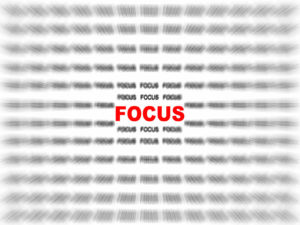
What Is Peripheral Awareness and How Important Is It?
We all know that maintaining a full field of vision is important. Arguably, though, one of the most important components of vision is peripheral awareness.
 Just think about when you are driving during rush hour. You’re focused on the car in front of you because traffic is starting and stopping very rapidly. However, you still need to be aware of the cars on each side of you. Your peripheral awareness is what allows you to take in the movements of the cars on your sides without removing your focus on the action in front of you.
Just think about when you are driving during rush hour. You’re focused on the car in front of you because traffic is starting and stopping very rapidly. However, you still need to be aware of the cars on each side of you. Your peripheral awareness is what allows you to take in the movements of the cars on your sides without removing your focus on the action in front of you.
Peripheral awareness is important because it gives us a better idea of what is going on around us, not just in front of us. It’s a skill that is vital because it allows us to react to movement just outside of our line of sight.
For instance, let’s say you are walking down a hallway looking straight ahead. Suddenly, someone walks out of a door you are passing on the right. Your peripheral awareness allows your body to react quickly to avoid running into the other person.
To keep their guard up and their game at its best, most athletes need good peripheral awareness. It not only helps to make them better players but also to avoid injury.
The ability to see the world around us is what peripheral awareness is all about. It is the opposite of having tunnel vision. Children develop their peripheral awareness as they age. Have you ever tried to show your child something while their eyes are glued to the television screen? Their tunnel vision is so strong it prevents them from being distracted. However, by their pre-teens, they should have adequate peripheral vision.
Eye Exercises to Improve Peripheral Awareness
One of the ways you can improve your peripheral awareness is through eye exercises. Eye exercises are designed to work the muscles of your eyes, just like sit-ups are designed to build the abdominal muscles. There are different exercises to help with different vision issues, but these should help with peripheral awareness.
Just like any exercise, the results aren’t immediate. You don’t do three crunches and lose 12 inches off your waist. Similar to dumb bell reps, eye exercises should be slow, steady, and consistent.
If you think your peripheral awareness is not as good as it should be, try this simple exercise. Turn on a television program with a lot of activity, something like a fast-paced sporting event. Turn your head and look at the wall beside the television.
Now try to relax your eyes and let the one closest to the TV take in the movements taking place on the screen. But, do not move your head or take your central focus off the spot on the wall. Did you find this task difficult? Now try it with the other eye. How much of the game can you see or comprehend from just your peripheral vision? People with strong peripheral vision can detect many movements and actions. But, if this is difficult for you to do, you may need to improve your peripheral vision. Adding these exercises to your daily routine should do the trick!
Wall Ball
As the name suggests, this exercise requires a wall and a ball (like a tennis ball). Find a spot on the wall to look at just above eye level. Throw the ball against the wall, bouncing it from your right hand to your left hand and then back again. While you are throwing the ball, you should be using your peripheral vision to understand where the ball is without looking directly at it.
You’ll likely drop the ball a few times getting used to this exercise. It may take some practice to get your eyes to relax enough to be able to do this. You should try doing this 10 times, once a day. This is enough to give your eyes a workout without overworking them.
High Toss
This is another exercise that requires only a wall and a ball. This time, you will stand four to five feet from the wall, facing it. Select a spot just above eye level on the wall to focus on. Throw the ball over your head from one hand to the other without moving your head. Your peripheral vision will allow you to track the ball.
This exercise is more challenging than the other wall-ball exercise. Since your arms are above your head, they’re also out of your central field of vision. The ball will leave your peripheral vision when you begin tossing it high enough. This will cause your peripheral vision skills to gain speed as it tries to track the ball when it comes back into your field of vision. Again, try to do this exercise 10 times without looking at the ball.
Other Ways to Improve Peripheral Awareness
You can also try out some of our free eye exercises to see which ones work for you. Eye exercises should also be paired with proper eye nutrition. Did you know there are 17 essential vitamins, herbs, and minerals that are necessary for optimum eye health? Check out the list and see how many of these you are eating every day. If you are lacking in them, try improving your diet. Make sure you are adding foods that are rich in these nutrients. If eating an eye-healthy diet every day isn’t realistic for your lifestyle, consider a natural alternative. Natural supplements contain the vitamins and minerals your eyes need but are more convenient to consume.
Peripheral awareness is one of the eye skills that is most necessary for our own safety. It allows us to prepare for objects and people that are approaching us. This could help you keep from having a side impact crash with another vehicle. It could keep you from getting hit by an errant frisbee at the park. Or, from taking a bad hit while on the court or field. Take the necessary steps to improve your peripheral awareness and you won’t regret it.
Our Rebuild Your Vision Ocu-Plus Formula Contains All 17 Vitamins, Minerals, and Herbal Supplements to Improve Your Eye Health!












I have RP, would peripheral vision exercises work for my condition. I hate the thought that I my go blind. Thank you